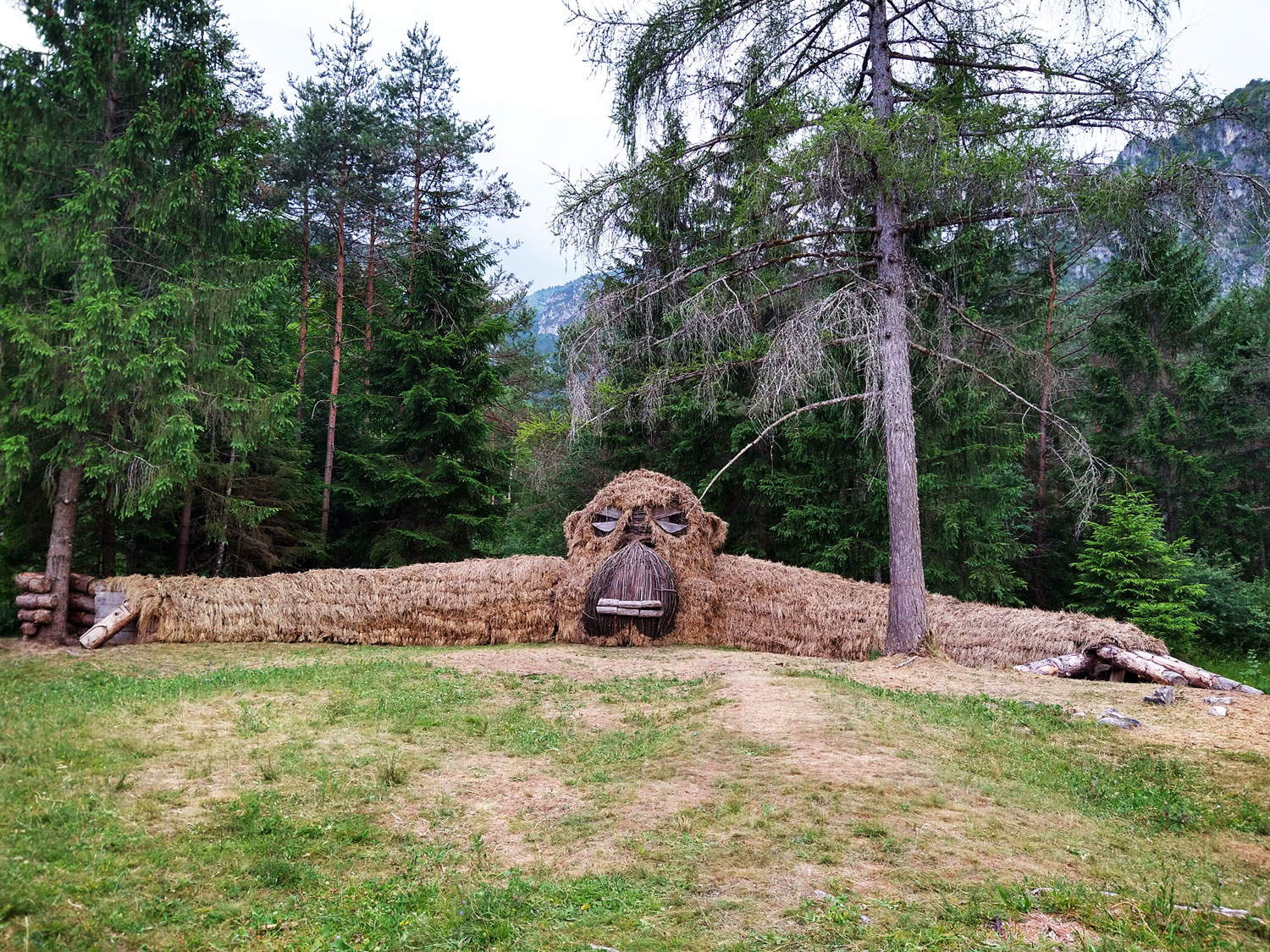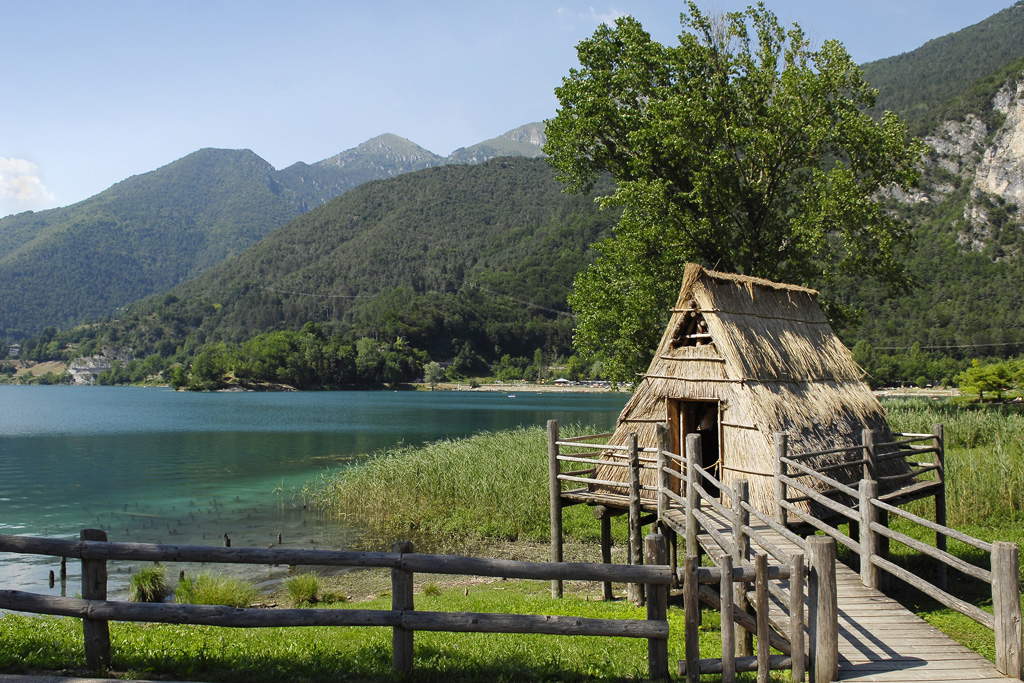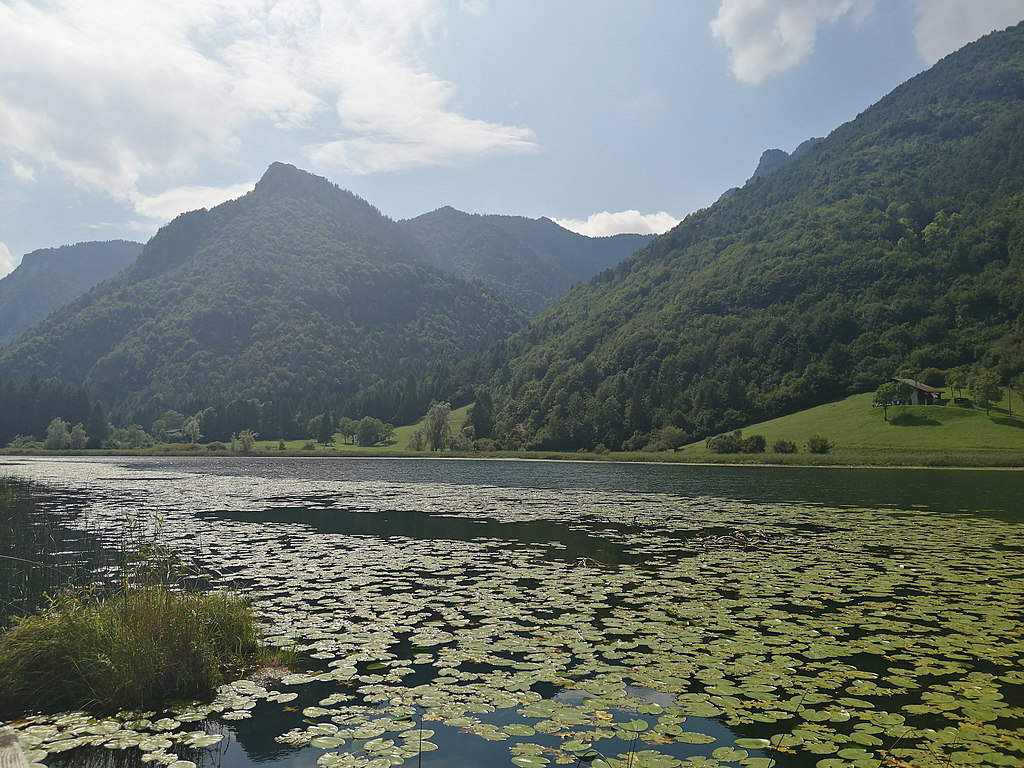A hidden gem among the mountains of Trentino, the Ledro Valley, which surrounds the lake of the same name, is a destination known for its natural beauty and rich historical heritage. The crystal-clear waters of Lake Ledro, amid lush forests and lush green meadows, reflect the surrounding mountains and create a tranquil and relaxing atmosphere, offering the opportunity to stroll along its shores, rent a boat, lie on the beach, discover the very long history of this land (the pile dwellings of Lake Ledro testify that the valley was already inhabited during the Copper Age) or simply enjoy the view. The Ledro valley then is surrounded by spectacular natural landscapes: paths and hiking trails run through forests, pastures and smaller valleys with a surprising variety of flora and fauna, and several routes are also suitable for those who love cycling or mountain biking. For those who do not like walking so much, however, there are picturesque villages and mountain hamlets that allow immersion in the authentic atmosphere of the valley. There are also many restaurants and trattorias where you can enjoy typical Trentino cuisine in the valley’s restaurants and trattorias, far, even in high season, from the hustle and bustle of the more popular Trentino valleys. The Ledro Valley is thus a destination that offers much to see, enchanting with its unspoiled nature, fascinating history, and relaxed atmosphere. Whether you are interested in exploring historical sites, doing outdoor activities, or simply enjoying the beauty of the landscape, this valley offers something special for every type of traveler. What to see in the Ledro Valley? Here are ten must-see destinations!
Of course, one can only start with Lake Ledro, which is located in the center of the valley, and overlooked by the villages of Pieve di Ledro, Mezzolago, and Pur (all hamlets and localities of the scattered municipality of Ledro, which brings together all the villages and hamlets of the valley). Situated at an altitude of 655 meters, Lake Ledro is glacial in origin, covers an area of about 2.18 square kilometers, and reaches a maximum depth of about 48 meters. Its waters are deep blue and crystal clear, set among the majestic peaks of the Alps. Lake Ledro is ideal for a range of water activities. You can swim in its crystal clear waters during the summer months and relax on its beaches. You can also rent canoes and paddleboats to explore the lake leisurely. There are also several beaches along the shores of the lake and picnic areas in the meadows, which are ideal for spending time relaxing and enjoying the view. The lake also has a grim past: in fact, it was a theater of war during World War I, so much so that the population of the villages was entirely evacuated, and even today, in the mountains, it is still possible to visit Austro-Hungarian lines and trenches dug into the rock.

Pieve di Ledro is a charming historic village located in the Ledro Valley. This picturesque village is the main town in the valley, the seat of the Municipality of Ledro (until 2009 it was an autonomous municipality), and lies along the northern shores of Lake Ledro, surrounded by the peaks of the Alps. This location offers splendid views a peaceful and relaxing environment. The small historic center, from which the shores and beaches of the lake can be reached on foot, is very characteristic. Worth seeing, in the historic center, is the ancient Church of the Annunciation, a religious building dating from the 13th century but later rebuilt in larger forms in the 16th century and then consecrated in 1652: the exterior is in neoclassical style, while the interior houses a 17th-century altarpiece depicting the Annunciation. Pieve di Ledro is then an ideal starting point for excursions and nature walks. Numerous well-marked trails lead through the landscapes of the Ledro Valley, allowing you to explore the beauty of this area of Trentino and the surrounding mountains.

The two villages of Tiarno di Sopra and Tiarno di Sotto are located along State Road 240 in Loppio and Val di Ledro and are the first two villages one encounters coming from the Giudicarie Alps a short distance away. They are two placid historic villages, rich in architectural features typical of these mountains, nestled along the valley meadows, a short distance from the lake. In the past, like Pieve di Ledro, they had been autonomous municipalities. In Tiarno di Sotto you can visit the delightful neoclassical chapel of Sant’Angela Merici, built at the behest of a local patron, Giacomo Ferrari, and where you can see 20th-century frescoes by Mantuan painter Agostino Aldi, who worked in the valley in the early years of the Century, and the parish church of San Bartolomeo: the latter’s bell tower is one of the tallest in the region, at 72 meters high. The interior houses the most interesting pictorial masterpiece in the Ledro Valley, Ferdinando Valdambrini’s enigmatic Last Supper, a 17th-century work.

A forest where art meets nature: so, on these pages, Ilaria Baratta wrote about Ledro Land Art, an interesting contemporary art project in the Ledro Valley, in a fir forest just above the village of Pur. The “pine forest of Pur,” this is the name of the forest, is one of the green lungs of the Ledro Valley, and here since 2012 this project has been going on that brings contemporary art to the valley, transforming the landscape through art installations made with natural materials found in the area. Ledro Land Art is basically a form of environmental art in which artists create works of art using only natural materials such as stones, woods, leaves, branches and other elements found in the surrounding nature. This approach emphasizes harmony between the artwork and the natural environment. Ledro Land Art works are created in situ: the artists respond to their surroundings, using the features of the landscape as a source of inspiration and as an integral part of their creations. In addition, an interesting aspect of Ledro Land Art (common to all environmental art) is the temporary nature of the works: many of these installations are intended to change over time due to weather conditions and the natural decomposition of materials, and this adds an element of ephemerality and transience to the art, highlighting the changing nature of the landscape. Finally, Ledro Land Art is not only a work of art, but also a way to engage the local community and visitors in promoting the culture, art, and natural beauty of the Ledro Valley.

It is located in Molina di Ledro, on the eastern shore of the lake, and is a section of the Trento Museum of Science (MUSE). The Lake Ledro Pile Dwelling Museum is dedicated to the preservation and presentation of archaeological artifacts from prehistoric pile dwellings that were located on the shores of Lake Ledro during the Bronze Age. The Lake Ledro pile dwelling research project began in 1929, when the water level of the lake was lowered for the construction of a hydroelectric power plant in Riva del Garda. During this process, numerous artifacts were discovered, including remains of wooden structures and well-preserved organic materials. The museum opened in the 1970s to enhance the archaeological remains found in the lake and to immerse the public ... in a real Neolithic village, thanks to faithful reconstructions of the pile dwellings. A new exhibit divided into four thematic sections was also inaugurated in 2019. Among the most interesting exhibits is a canoe carved from a single fir log more than five meters long, dating back some 3,600 years.

Val Concei is a beautiful side valley located in the northern part of Lake Ledro, renowned for its dense forests. It is easily reached in a few minutes from Pieve di Ledro and develops around the pretty villages of Locca, Enguiso and Lenzumo, where it is worth taking a walk among the stone houses, occasionally running into the flocks led by the shepherds active in these parts, or observing the lush crops (the Val Concei strawberries are excellent). Val Concei represents the “wildest” part of Val di Ledro: from here trails lead to the area’s most impressive peaks (at over two thousand meters above sea level), passing through its famous, lush forests. The most popular nature trail, which in the first part is suitable for everyone, starts shortly after the village of Lenzumo and is full of wood carvings inspired by the legend of the Fairy Gavardina, who was said to live in the woods of Val Concei. In winter, Val Concei is a popular destination for cross-country skiers thanks to the presence of the Chinaec, a beautiful slope suitable for everyone. Val Concei is also home to the oldest tree in Val di Ledro, a centuries-old beech tree over thirty meters tall and located in the locality named after it (“Al Faggio”).

A fascinating place for lovers of nature and mountain environments, the Ampola waterfall is located about 5 kilometers away from Lake Ledro, not far from the state highway leading to the Giudicarie Alps. It is included in a nature park, the Forte Ampola Park, which is also of historical importance, since it stands on the remains of the old Forte Ampola, used during World War I: in fact, the site tells the story of the fort and, more generally, of the Ledro Valley during World War I. The waterfall can be observed from a footbridge that passes over the rio Citta, crosses the Austrian bastion, and offers a beautiful view of the waterfall. Moreover, the park is part of the Trentino Grande Guerra network, a network of museums and historical sites dedicated to World War I in Trentino. From a naturalistic point of view, the park is a “special conservation area,” especially important for flora: rare endemic species are found here.

Lake Ampola is a small alpine lake, of glacial origin, located in the upper Ledro Valley, not far from Tiarno di Sopra and easily accessible from the state highway 240 of Loppio and Val di Ledro: it is often considered a hidden gem, less well known than the nearby Lake Ledro, but just as fascinating, especially because it is one of the rare alpine lakes that still occurs in its natural state, surrounded exclusively by woods and vegetation where many animals of different species thrive. The only human presence is the wooden footbridge that runs along the banks and helps visitors observe the plants and animals. Not far away is the Visitor Center (open only from July to September), which offers information on the natural environment of the lake and particularly on wetland life. Precisely because of the specificity of this environment, in 1990 Lake Ampola was recognized by the Autonomous Province of Trento as a biotope.

It means “whirlpool of the abyss” in the local dialect, similar to eastern Lombard (the dialect of the inhabitants of Val di Ledro may resemble that of the valleys of Brescia) and is a scenic waterfall carved into the rock by the Massangla stream. You can reach it on foot starting from Tiarno di Sotto, and on the way you can see the ancient Mulino dei Bugatini, dating as far back as the 15th-16th centuries, the only mill left along the Massangla, and the 15th-century small church of San Giorgio: in about 20 minutes you will reach the waterfall, with an easy route suitable for everyone. At the end you will find yourself in front of the fairy-tale scenario, that of the waterfall that flows through the rocks into a pool of water, giving you moments of great fascination, in all seasons: in summer, when you are looking for coolness, and in winter, when the water that falls on the rocks in many places becomes ice and the waterfall becomes even more spectacular!

The road to get there, from the hamlet of Lenzumo in Val Concei, is not the smoothest: seven kilometers of winding, single-lane climbs along a route popular with cyclists, but eventually you will arrive at one of the most popular malghe in this area of Trentino, where you can stop to taste the typical cuisine or simply watch the cows graze in the summer. Like almost all malghe (this term is used to indicate the buildings that serve the mountain pastures, i.e., the areas where the cows are taken to graze in summer), Malga Trat is open only in the warm months, from May to October. You can see the barn, the farmstead, the milking parlor, and there is also a dairy with direct sales of products, including nostrano di malga, made from cow’s milk, goat’s milk cheeses, ricotta, and the famous and genuine malga butter.

 |
| Ledro Valley, what to see: the 10 places not to miss |
Warning: the translation into English of the original Italian article was created using automatic tools. We undertake to review all articles, but we do not guarantee the total absence of inaccuracies in the translation due to the program. You can find the original by clicking on the ITA button. If you find any mistake,please contact us.